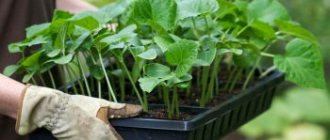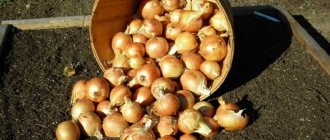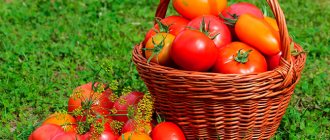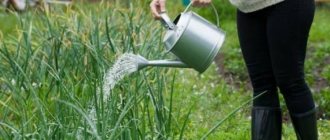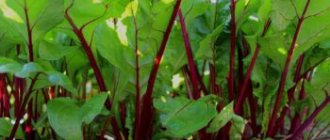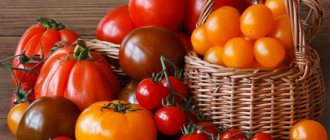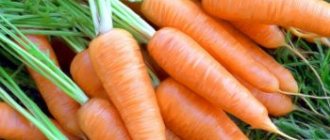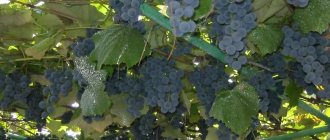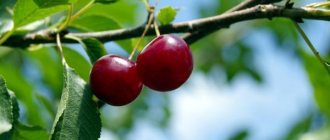Vegetable growing » Onions
0
2637
Article rating
Kira Stoletova
In order to grow onions in the Moscow region, you need to know which varieties germinate best in these climatic conditions, how to plant correctly and when to plant onions in the Moscow region.
Onions for the Moscow region
Features of onion varieties for the Moscow region
Onion varieties are varied. When choosing, a gardener only needs to decide what is most important to him first of all: the size of the bulbs, the ripening period or the storage period. According to the ripening time of onion varieties, they can be divided into:
- early (less than 100 days);
- mid-early (100-110 days);
- mid-season (110-120 days);
- medium-late and late (more than 120 days).
The latter are not suitable for the Moscow region: in this climatic zone they have little sun, and the day length is unsuitable for ripening. True, some mid-late and late varieties can be grown through seedlings. However, ripening times can vary significantly depending on the soil, weather, planting depth, etc.
Which onion to choose for planting in the Moscow region must be decided based on various factors
In the Moscow region, sharp and semi-sharp onions are most often planted. It is impossible to grow sweet salad varieties (southern) here, since they require 140-160 warm days to ripen. The taste of onions depends on the content of essential oils, dry substances, and sugars. There are more of the latter in sharp onions than in semi-sharp ones. And it seems more bitter due to the fact that it also contains a lot of essential oils, which cancel out the sweetness.
The length of onion storage also depends on the sucrose and dry matter content in onions. In order for the cultivation of this crop to be successful, it is important to choose the right varieties for the climate zone in which you live, since onions react sharply negatively to changes in geographic location.
Rules for selecting seedlings for planting
Before you start planting seedlings, you should decide what qualities the final product should have.
Typically, summer residents prefer to simply buy planting material at the nearest gardening store. But you can do something more difficult - prepare the sets yourself and save on buying it.
It doesn’t matter which of these two methods you choose, but you should definitely know all the criteria that you need to focus on when selecting seedlings. When choosing a set, the following main parameters are distinguished:
- Taste qualities. This parameter is worth paying attention to first of all, since onions are grown for human consumption.
- The variety's resistance to environmental conditions, for example, high humidity or frost. If the seedlings depend on such indicators, then their growth will not be active. Therefore, when choosing planting material, do not forget that it is not recommended to frequently touch the seedlings during storage before planting, since such actions can speed up their germination.
- Seedlings should smell like regular onions and not have the smell of rot, dampness or mold.
- Form. The shape of the onion depends on the characteristics of the particular variety or variety. Summer residents rarely pay attention to this, since most are interested in the taste of the vegetable, and not in what shape the grown onion will have - round or elongated.
- A batch of good quality purchased sets may contain a few dried onions, but they rarely exceed one percent of the total.
- High-quality onion sets are always covered with dry husks. Its presence indicates that the planting material has been well dried.
- The bulbs should not show any signs of mechanical damage.
- Well-dried sets are considered the most suitable for planting, but wet bulbs are allowed in the batch. They will need to be separated from the dry ones and dried.
- Each bulb, with its color and size, must confirm its belonging to the selected variety.
- Good planting material should have a uniform color, and there should be no strange spots on it.
- When purchasing onion sets, ask the seller to provide you with the exact name of the variety, shelf life of the crop and its main characteristics. Such information is very important, because different varieties differ from each other and have different characteristics that affect the germination of planting material and productivity. If the sets are sold in packaging, then look for this information on it.
- Appearance. The main sign of a high-quality set is the dense structure and smooth surface of the onion. The husks should not show signs of disease and rot, as well as traces of pest activity.
The best onion varieties for the Moscow region
A good onion harvest can be obtained not only by selecting first-class planting material, but also by using a suitable variety of sets for planting. Each of them has its own characteristics, including cost, yield, ripening time, and shelf life. The place for this purpose can be warm or cold. The first option involves storing onions at a temperature of +18-20 degrees and a humidity of 70%.
In the second case, the onions are kept at a temperature of +18 degrees until the frost outside reaches -10 degrees. Then the temperature in the storage is lowered to -1 degree and the onions are stored like this until spring. When conditions become favorable - spring warming comes - the bulbs are placed in a warm place to awaken them, after which they are planted in open ground.
Growing methods
Most often, onions are grown using a two-year method. In the first spring, nigella is sown, which will produce small bulbs by the end of the summer season. This planting material is used in the second year to obtain a large and large onion harvest. Some gardeners use another method - sowing seeds. To do this, planting material must be planted in open ground in early spring, as soon as the snow melts and the soil warms up slightly. Before sowing, the seeds must be kept in a damp cloth for 1 day.
Onions are an unpretentious crop and do not require greenhouse conditions. The climate in the Moscow region allows you to grow vegetables both in open ground and in a greenhouse. But if there is a need for late harvesting, then you can use shelter in the form of a greenhouse. This growing method has its own characteristics:
- Choose the right place to plant. The best predecessors of onions are eggplants, tomatoes, carrots and beets.
- Use strong and healthy planting material.
- To obtain large bulbs, it is important to plant the sets so that the distance between plants is 8-10 cm.
- Ensure soil breathability. Frequently loosen and remove weeds.
- It is worth remembering that you cannot grow onions in the same place for 2 years in a row.
The best varieties of onions for storage in the Moscow region
Below are the varieties most suitable for growing in the Moscow region:
| Variety name | Characteristic |
| Sturon | Early ripening variety. Excellent taste. The sharpness is low. Bulbs of medium and large sizes that have reached technical ripeness. Their weight is 90-150 g. High yield, good germination. They begin to harvest it 8-12 days before the usual collection date. Resistant to diseases. Has excellent keeping quality. |
| Stuttgarten Riesen | The variety is early ripening. The shape of the fruit is flat or round flat. They have medium and large sizes. It has a pronounced pungency. The weight of the bulbs is 50-94 g or 150-300 g. The variety is rich in vitamin C. It is not resistant to neck rot or powdery mildew. High germination and productivity. Long-term storage is possible for the variety. |
| Centurion | New variety. The fruits have a standard shape. Their weight is 110-150 g. Good keeping quality. The taste is moderately spicy. With good care, the variety is highly productive. Under favorable conditions, germination is one hundred percent. The variety is resistant to diseases. It has good keeping quality. |
| Hercules | Mid-early variety. The shape of large bulbs is round. At the stage of technical maturity - ellipsoidal. Excellent keeping quality, good taste. Medium spiciness. The variety is high-yielding. It is resistant to pink and bottom rot, fusarium. |
| Red Baron | Early ripening variety. The fruits are red or purple, round. Weight 25-40 or 130-150 g, excellent keeping quality. Good taste. The sharpness is slight. Productivity is stable. The maturity is excellent. |
| Orion | Exclusive variety, early ripening. Belongs to English. The fruits are perfectly round and large. Weight 150-200 g. Frost-resistant. Has high keeping quality. |
Onion Sevok is one of the most win-win options for a wide variety of climates
Dmitrich
Ideally suited for planting onion sets before winter in the Far Eastern region: Amur, Kamchatka, Sakhalin and Magadan regions, Primorsky and Khabarovsk territories.
This is a cultivar characterized by mid-ripening. The bulb of this variety is transversely elliptical, its weight ranges from 55 to 70 g. Dry scales are brown, juicy scales are white with green. There are three dry scales. The neck is of medium thickness. The onion has two or three rudiments. The taste is decent, the onion is semi-sharp.
You can harvest about 1.8 kg/m², but the maximum yield in the Khabarovsk Territory reaches 2.7 kg/m². Before harvesting, the ripening rate of the bulbs is 76%; after ripening, as a rule, 90% of the harvested bulbs ripen. Suitable for storage.
Suitable for growing onion sets before winter in the Volga-Vyatka region: Kirov region, Mari El Republic, Nizhny Novgorod region, Perm region, Sverdlovsk region, Udmutt Republic, Chuvash Republic.
We suggest you read How to grow tulips on a windowsill in winter
This is a cultivar characterized by mid-ripening. The bulb of this variety is round, its weight ranges from 60 to 90 g. Dry scales are dark red, juicy scales are white with a reddish tint. There are two or three dry scales. The neck is of medium thickness. The onion has two buds. The taste is decent, the onion is semi-sharp.
You can harvest more than 2 kg/m², but the maximum yield in the Mari El Republic reaches 4.12 kg/m². Before harvesting, the ripening rate of the bulbs is 78%; after ripening, as a rule, 97% of the harvested bulbs ripen.
Popular varieties of red onions for the Moscow region
To grow a good harvest of red onions, you need to pay attention to the following varieties:
| Variety name | Characteristic |
| Bombay | Dutch mid-season variety of red salad onion. The feathers and bulbs are mild, very tasty, rich in phytoncides and vitamins. The fruits are large and dense. The shape is flat. The color of the husk is dark red. Inside – light lilac. Semi-sharp taste. Keeping quality is good. |
| Brunswick | The early ripening variety is very popular. If you grow it through seedlings, you can get an excellent harvest. The diameter of the flat-rounded bulbs is up to 6 cm. Their dry scales are bright purple, the fruits are pink inside. Good keeping quality. |
| Carmen | The variety is mid-season. Ripening period is 120-130 days. The bulbs are dark red with a purple tint. Their weight is 50-70 g, the taste is semi-sharp. |
| Red Baron | The early ripening variety already described above. Ripening period is 92-95 days. The bulbs are round or flat-rounded. Their weight is 18-24 g. The taste is semi-sharp. |
Characteristics
- The ripening period is no more than 120 days. By the time of harvesting in August, late onions do not have time to ripen, so early and mid-season varieties are planted in the region.
- Frost resistance. Winter temperatures can drop below 25-30 degrees, and the amount of snow that falls is sometimes not enough to protect the sets planted before winter (read about onion varieties grown before winter here).
- Resistance to shooting. In spring there are sharp temperature fluctuations and frosts, so there is a high risk that plants that have not taken root in time will sprout. As a result, the onion head will not form.
- Disease resistance. Summers in the region are wet and cold, causing bacterial and fungal diseases to occur. This significantly affects the yield.
- Good keeping quality. Sometimes the ripening and harvesting period of the bulbs falls during the rainy period.
- Sharp and semi-sharp varieties are chosen due to the possibility of long-term storage of the heads.
If you still want to grow sweet late-ripening varieties with a ripening period of more than 120 days, use the method of growing seedlings.
Until recently, it was customary to plant onion sets in the spring. But with the advent of new frost-resistant varieties, winter planting is becoming increasingly popular.
Popular varieties of large onions
Large bulbs have the following varieties:
| Variety name | Characteristic |
| Globo | The variety is mid-season. Among the salad varieties, one of the largest. The bulbs are round, light yellow. Their weight can reach 1 kg. They are very juicy and sweet. The variety is grown through seedlings. |
| Exhibition | Medium late variety. The bulbs are huge, weighing 500-800 g. The taste is sweet, without bitterness. High shelf life - 3-4 months. |
| Texas yellow | Dutch variety. Very popular not only in the Moscow region, but also in Siberia. Grows quickly and easily, forming 1 good head per season. Large dense bulbs with mild flesh have a straw-yellow color. The variety is resistant to pink rot. |
The yield of onions is directly affected by the composition of the soil, care, feeding and fertilizers.
What determines the sweetness of onions?
The quality of onions often depends on the area where they are grown. For a long time, breeders have developed varieties that are most suitable for different regions. There are several main reasons why an onion can be very bitter:
- Lack of fertilizers with phosphorus. In some cases, people with experience recommend adding more fertilizer with superphosphate.
- For good taste, onions need moist, but not swampy soil. When grown in dry soil, the bulb will develop a bitter taste.
- Unsuitable climate. It is important to consider the weather of the region when choosing seeds. If it is not suitable, the vegetable will lose its taste characteristics and become bitter.
Sweet onions can be eaten raw
Attention! When growing any type of onion, you need to pay attention to the conditions and follow the rules of agricultural technology.
The best varieties of onions for open ground
The best varieties of onions for open ground in the Moscow region are Stuttgarten-Riesen and Strigunovsky. They have a pungent taste. They have excellent keeping quality. Undemanding in care, tolerant of lack of moisture. More productive varieties - Kaba, Carmen, Globus - on the contrary, are demanding in terms of growing conditions and fertilizing.
They are grown both by seedlings and by sowing seeds. They are distinguished by lower density, but greater juiciness, fewer surface scales, which is why their shelf life is not very good. When harvesting, it is important not to damage the bulb.
Planting and care
It is better to make the height of the onion beds about 15 cm, and the width between the ridges is 1 meter. Raised growing allows for a steady supply of light, air and moisture to the bulbs. Place the seedlings in prepared beds to a depth of 4 cm, the distance between plants is 10 cm. After digging the furrows, it is better to mulch them with humus. If the planting material is in the form of seeds, then sowing is carried out to a depth of 2 cm. The approximate scheme is 13 * 1.5 cm. After planting, water the beds with warm water from a shallow watering can.
In addition to periodically loosening the soil and removing germinating weeds, onions require additional care:
- Watering is carried out once a week. For every square meter of planting, use 7-10 liters of water. But it is important to take weather conditions into account. In dry summers, daily watering may be necessary.
- Onions are fertilized with an organic solution if germination is poor. At 10 l. 1 glass of urea or mullein is diluted with water. For 1 sq. m. 3 liters of fertilizer are applied. The same solution will be needed in 2 weeks.
- Treatment for diseases consists of spraying the green part of the onion with a solution of copper sulfate (1 tsp per 10 liters of water).
Taking care of the beds will allow you to reap a rich harvest of onions and provide your family with a healthy vegetable for the whole winter.
The best onion varieties for forcing in greenhouses
If you have a greenhouse, then you can enjoy green onions all year round. Growing onions in a greenhouse is quite easy if you maintain optimal temperature conditions, light and humidity requirements and provide the required amount of organic and mineral substances in the soil. Early and early ripening varieties with a short dormant period and a short growing season are suitable for this.
The best popular varieties and hybrids for forcing into the pen in the Moscow region are Karatelsky, Danilovsky 301, Mastersky local, Bessonovsky local, Skopinsky, Ryazansky. Among the new ones: Stuttgarten Risen, Globus, Centurion F1, Universo F1, Supra, Kaba, Bamberger, Krasnodar G-35, Spanish 313. In greenhouses you can also grow leeks, chives (Crocus variety), shallots (Elan varieties) for greens. Off-season), batun (varieties Picnic, Izumrudny, Parade, Tenderness, Ladoga).
Growing onions in a greenhouse
Preparing the landing site
The area for growing onions should be level and as open to sunlight as possible. The soil is loamy or sandy loam. Optimal neighbors include parsley, tomatoes, spinach and lettuce. It is better to carry out preparatory work in the autumn after the previous harvest.
At the first stage, the soil should be loosened to a depth of 10 cm with the obligatory removal of weed roots. The second stage is carried out after 2-3 weeks, it consists of deep digging and applying fertilizer. Per sq. meter needed:
- humus 5 kg;
- compost 8 kg;
- chicken manure 200 g;
- wood ash 0.5 kg;
- 20 g superphosphate;
- 15 g of potassium chloride.
If you have to grow onions on peat soils, then there should be 1.5 times more phosphorus fertilizers. It is better to refrain from adding potassium supplements.
The most productive onion varieties for the Moscow region
When choosing the most productive varieties, it is better to prefer strictly zoned varieties - only local varieties turn out to be the most productive in 99 cases out of 100.
| Variety name | Characteristic |
| Strigunovsky local | This is one of the most productive varieties of hot onions. The variety is mid-season - ripening period is 77-98 days. The bulbs are slightly flattened or rounded. pinkish-yellow. Very juicy, dense. If you grow the variety from sets, the harvest will be especially successful. |
| Kaba | The best variety of hot onions for the Moscow region, Non-Black Earth Region and the middle zone. The variety is mid-season - ripens in 120-140 days. The bulbs are large, their weight is up to 200 g. The color is golden yellow with a brown tint. |
| Red Baron | The most productive variety of southern onion is semi-sharp, pleasant, and not very sweet. The weight of juicy dark red fruits is 130-150 g. Keeping quality is quite high for multi-colored varieties. Early ripening - ripens in 92-95 days. |
| Snowball | One of the best varieties of white onions. The bulbs are white, almost round, very juicy, their weight is about 100 g. The variety is mid-early, resistant to bolting. Keeping quality is good. |
Frost-resistant onions for winter planting
Winter planting of onions on turnips is becoming increasingly popular. It has significant advantages: in the spring there is no need to rush to cultivate the beds, plant onions on turnips, and water until mid-May; with this planting, the bulbs grow much larger than those of spring onions, and winter varieties ripen much earlier - at the end of May. True, they have little shelf life.
For winter plantings, it is recommended to choose specially bred varieties of short daylight, frost-resistant hybrids. Late varieties and those that are usually grown in the southern regions are not suitable for the Moscow region. Incorrectly selected onion varieties do not tolerate winter well, and this leads to bolting and low yields.
"Belozerets"
This variety was also bred by employees of the Krasnodar Research Institute. It has a number of significant differences from its “brother”:
- precocity;
- oval and round-oval bulbs weighing 20-27 grams;
- small variety;
- pungency of taste;
- the color of the scales is light lilac.
Onion varieties intended for cultivation
Despite the widespread use of onions in cooking, turnips also have excellent taste and nutritional properties. To obtain greens, they turn to growing excellent varieties of onions.
Winter onion varieties
Experts recommend varieties bred in Holland:
| Variety name | Characteristic |
| Shakespeare | A very popular and reliable winter variety. Early ripening: the heads ripen in just 75 days. The scales are brown, the flesh is white, juicy, the taste is semi-sharp. The fruits are round and large. Weight is about 100 g. The dense shell makes it possible to withstand low temperatures. The variety is resistant to diseases. |
| Radar | Mid-season variety. The taste is excellent. Good keeping quality, high yield. The fruits are large, their weight is 150-300 g. The husk is light yellow. |
| Ellan | Early ripening variety. The harvest can be harvested from mid-June. The bulbs are beautiful yellow or straw color, round in shape, 6-8 cm in diameter, weighing 80-120 g, white inside, juicy. The taste is pleasant sweetish. |
| Senshui (yellow) | Early ripening, high-yielding and resistant to bolting and powdery mildew. The fruits are flat-round. They have excellent keeping quality. |
| Stuttgarten Riesen, Sturon, Centurion, Kip-Vel | The bulbs of the German variety Stuttgarten Riesen are large, flat-round. The Sturon variety is high-yielding, Centurion is early-ripening, Kip-Vel is drought- and frost-resistant. |
When choosing an onion variety for the Moscow region, pay attention to what climate it is most suitable for and what care it needs
Harvest and storage
Mesh, cardboard boxes, wooden boxes with holes for air intake are suitable as storage containers.
How and when to collect
Onions are harvested after the above-ground part of the leaves turns yellow and dries - in late spring and early summer. Full collection is carried out before the beginning of August, in dry, windless weather. The dug up crop is left for some time in the garden bed to dry, left in the sun, spread out in a thin layer. The top feathers are removed. Then they are placed in containers and moved to a cool room for permanent storage.
Storage features and keeping quality of the variety
If onions are stored in an apartment , the temperature should be +18...+22°C, humidity – 50-70%. In basements, the optimal values are 0...+3°C with a humidity of 75-90%. During storage, vegetables are sorted, rotten ones are removed, and wet ones are dried.
Important! Winter onions can be stored for about 6-8 months.
Top 7 best varieties of onions for the Moscow region
Experienced gardeners choose the following varieties for planting:
| Onion variety | Application | Bulb weight | Taste of fruits | Keeping quality | ||||
| Kaba | Salads, preserves | 70-145 g | Peninsular | Bad | ||||
| Red Baron | Salads, preserves | 130-150 g | Peninsular | Excellent | ||||
| Snowball | In salads | 120-200 g | Peninsular | Average | ||||
| Strigunovsky local | For salads, preservation | 45-80 g | Very spicy | Excellent | ||||
| Sturon | For salads, preservation | 70-180 g | Spicy | Excellent | ||||
| Texas yellow | Salads, preserves | 80-150 g | Peninsular | Average | ||||
| Centurion F1 | Salads, preserves | 65-180 g | Spicy | Excellent | ||||
Common mistakes gardeners make
- When choosing a variety or hybrid of a particular crop, inexperienced gardeners often come to a rash decision: take the first ones they come across. They do not think about whether the selected varieties will grow well in their region. In order not to be disappointed, when purchasing, you need to clarify which varieties and hybrids are zoned in the region of your site. Only they will probably feel good in the local climate.
- One of the common mistakes of gardeners: in pursuit of a large harvest, they “overfeed” the plants with fertilizers, which as a result begin to dry out, get sick, or, on the contrary, become fattened. Due to excess fertilizer, nitrates that are harmful to humans accumulate in fruits.
We plant correctly
In order to grow onions, it is not enough to choose the most suitable variety for this region. You also need to know the basic rules for planting vegetables, which would lead to the desired result.
Of no small importance in this is what vegetables the onions will be planted after.
The most suitable option is to plant onions after grains. The only exception is oats.
Onions can also be planted after beets, peas or beans growing in the Moscow region. Tomatoes, cucumbers and cabbage are suitable as predecessors. At the same time, it is necessary to remember that it is worth planting onion crops after it itself no earlier than 4 years after harvesting the onion crop from such a bed.
For growing onions near Moscow, the choice is made in favor of wild oatmeal (turnips with a diameter of no more than 1 cm) and sets measuring from 1 to 3 cm. In addition, in the region, a selection reaching a diameter of more than 3 cm is often planted in the beds, intended to obtain early greenery in the region .
Read also How orchid flowers reproduce
With the arrival of spring comes the summer season. Gardeners are faced with many questions that need to be resolved in a short time. The most basic of these is the question of which crops to plant first this year.
Gardeners grow different types of vegetables and fruits, and onions are often among them. It is unpretentious, does not require special or complicated care, but is very often used in preparing various dishes.
The choice of such a crop for planting is quite justified, but often causes difficulties, since inexperienced summer residents experience some difficulties when selecting planting material among a wide variety of varieties. To make the right choice, you should know what characteristics and taste qualities a particular type of onion has.

